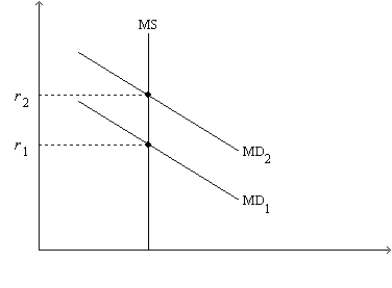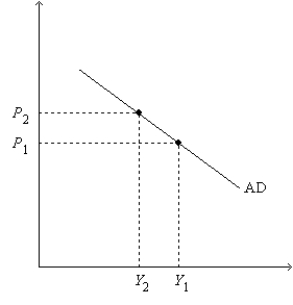A) purchasing government bonds. This action will reduce investment and shift aggregate demand to the right.
B) purchasing government bonds. This action will increase investment and shift aggregate demand to the right.
C) selling government bonds. This action will reduce investment and shift aggregate demand to the left.
D) selling government bonds. This action will increase investment and shift aggregate demand to the left.
F) A) and D)
Correct Answer

verified
Correct Answer
verified
Multiple Choice
In recent years, the Federal Reserve has conducted policy by setting a target for the
A) size of the money supply.
B) growth rate of the money supply.
C) federal funds rate.
D) discount rate.
F) B) and D)
Correct Answer

verified
Correct Answer
verified
Multiple Choice
If the government cuts the tax rate, workers get to keep
A) less of each additional dollar they earn, so work effort increases, and aggregate supply shifts right.
B) less of each additional dollar they earn, so work effort decreases, and aggregate supply shifts left.
C) more of each additional dollar they earn, so work effort increases, and aggregate supply shifts right.
D) more of each additional dollar they earn, so work effort decreases, and aggregate supply shifts left.
F) A) and B)
Correct Answer

verified
Correct Answer
verified
Multiple Choice
According to liquidity preference theory, if the quantity of money supplied is greater than the quantity demanded, then the interest rate will
A) increase and the quantity of money demanded will decrease.
B) increase and the quantity of money demanded will increase.
C) decrease and the quantity of money demanded will decrease.
D) decrease and the quantity of money demanded will increase.
F) A) and C)
Correct Answer

verified
Correct Answer
verified
Multiple Choice
People will want to hold more money if the price level
A) or if the interest rate increases.
B) or if the interest rate decreases.
C) increases or if the interest rate decreases.
D) decreases or if the interest rate increases.
F) All of the above
Correct Answer

verified
Correct Answer
verified
Multiple Choice
If the Fed conducts open-market sales, the money supply
A) increases and aggregate demand shifts right.
B) increases and aggregate demand shifts left.
C) decreases and aggregate demand shifts right.
D) decreases and aggregate demand shifts left.
F) C) and D)
Correct Answer

verified
Correct Answer
verified
True/False
Some economists, called supply-siders, argue that changes in the money supply exert a strong influence on aggregate supply.
B) False
Correct Answer

verified
Correct Answer
verified
Multiple Choice
Scenario 34-2. The following facts apply to a small, imaginary economy. • Consumption spending is $6,720 when income is $8,000. • Consumption spending is $7,040 when income is $8,500. -Refer to Scenario 34-2. The multiplier for this economy is
A) 1.31.
B) 6.25.
C) 2.78.
D) 2.27.
F) B) and C)
Correct Answer

verified
Correct Answer
verified
Multiple Choice
Which of the following events shifts the aggregate-demand curve leftward?
A) A decrease in government expenditures, but not a change in the price level.
B) An increase in government expenditures or a decrease in the price level.
C) A decrease in government expenditures or an increase in the price level.
D) An increase in the price level, but not a decrease in government expenditures.
F) A) and C)
Correct Answer

verified
Correct Answer
verified
Multiple Choice
Figure 34-2. On the left-hand graph, MS represents the supply of money and MD represents the demand for money; on the right-hand graph, AD represents aggregate demand. The usual quantities are measured along the axes of both graphs.
. 
 -Refer to Figure 34-2. As we move from one point to another along the money-demand curve MD1,
-Refer to Figure 34-2. As we move from one point to another along the money-demand curve MD1,
A) the price level is held fixed at P1.
B) the interest rate is held fixed at r1.
C) the money supply is changing so as to keep the money market in equilibrium.
D) the expected inflation rate is changing so as to keep the real interest rate constant.
F) A) and C)
Correct Answer

verified
Correct Answer
verified
Multiple Choice
When taxes increase, the interest rate
A) increases, making the change in aggregate demand larger.
B) increases, making the change in aggregate demand smaller
C) decreases, making the change in aggregate demand larger.
D) decreases, making the change in aggregate demand smaller.
F) A) and D)
Correct Answer

verified
Correct Answer
verified
Multiple Choice
Which of the following statements is correct for the long run?
A) Output is determined by the amount of capital, labor, and technology; the interest rate adjusts to balance the supply and demand for money; the price level adjusts to balance the supply and demand for loanable funds.
B) Output is determined by the amount of capital, labor, and technology; the interest rate adjusts to balance the supply and demand for loanable funds; the price level adjusts to balance the supply and demand for money.
C) Output is determined by the amount of capital, labor, and technology; the interest rate adjusts to balance the supply and demand for loanable funds; the price level is relatively slow to adjust.
D) Output responds to the aggregate demand for goods and services; the interest rate adjusts to balance the supply and demand for loanable funds; the price level adjusts to balance the supply and demand for money.
F) B) and C)
Correct Answer

verified
Correct Answer
verified
Multiple Choice
Which of the following properly describes the interest-rate effect?
A) A higher price level leads to higher money demand; higher money demand leads to higher interest rates; a higher interest rate increases the quantity of goods and services demanded.
B) A higher price level leads to higher money demand; higher money demand leads to lower interest rates; a higher interest rate reduces the quantity of goods and services demanded.
C) A lower price level leads to lower money demand; lower money demand leads to lower interest rates; a lower interest rate reduces the quantity of goods and services demanded.
D) A lower price level leads to lower money demand; lower money demand leads to lower interest rates; a lower interest rate increases the quantity of goods and services demanded.
F) A) and D)
Correct Answer

verified
Correct Answer
verified
Multiple Choice
Other things the same, which of the following responses would we expect to result from a decrease in U.S. interest rates?
A) U.S. citizens decide to hold more foreign bonds.
B) People choose to hold more currency.
C) You decide to purchase a new oven for your cookie factory.
D) All of the above are correct.
F) C) and D)
Correct Answer

verified
Correct Answer
verified
Multiple Choice
Critics of stabilization policy argue that
A) there is a lag between the time policy is passed and the time policy has an impact on the economy.
B) the impact of policy may last longer than the problem it was designed to offset.
C) policy can be a source of, instead of a cure for, economic fluctuations.
D) All of the above are correct.
F) All of the above
Correct Answer

verified
Correct Answer
verified
Multiple Choice
The government buys new weapons systems. The manufacturers of weapons pay their employees. The employees spend this money on goods and services. The firms from which the employees buy the goods and services pay their employees. This sequence of events illustrates
A) the accelerator effect.
B) the multiplier effect.
C) the chain effect.
D) the bandwagon effect.
F) A) and C)
Correct Answer

verified
Correct Answer
verified
Multiple Choice
The price of imported oil rises. If the government wanted to stabilize output, which of the following could it do?
A) increase government expenditures or increase the money supply
B) increase government expenditures or decrease the money supply
C) decrease government expenditures or increase the money supply
D) decrease government expenditures or decrease the money supply
F) A) and B)
Correct Answer

verified
Correct Answer
verified
Multiple Choice
If the MPC = 4/5, then the government purchases multiplier is
A) 5/4.
B) 4/5.
C) 5.
D) 20.
F) All of the above
Correct Answer

verified
Correct Answer
verified
Multiple Choice
In 2009 President Obama and Congress increased government spending. Some economists thought this increase would have little effect on output. Which of the following would make the effect of an increase in government expenditures on aggregate demand smaller?
A) the interest rate falls and aggregate supply is relatively flat
B) the interest rate falls and aggregate supply is relatively steep
C) the interest rate rises and aggregate supply is relatively flat
D) the interest rate rises and aggregate supply is relatively steep
F) A) and B)
Correct Answer

verified
Correct Answer
verified
Multiple Choice
If the MPC is 3/5 then the multiplier is
A) 4, so a $100 increase in government spending increases aggregate demand by $400.
B) 1.5, so a $100 increase in government spending increases output by $150.
C) 2.5, so a $100 increase in government spending increases aggregate demand by $250.
D) 1.67, so a $100 increase in government spending increases output by $166.67.
F) C) and D)
Correct Answer

verified
Correct Answer
verified
Showing 201 - 220 of 523
Related Exams